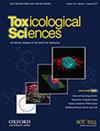Formaldehyde and the Transient Receptor Potential Ankyrin-1 Contribute to Electronic Cigarette Aerosol-induced Endothelial Dysfunction in Mice
IF 3.4
3区 医学
Q2 TOXICOLOGY
引用次数: 0
Abstract
Electronic Nicotine Delivery Systems (ENDS) aerosol exposures can induce endothelial dysfunction (ED) in healthy young humans and animals. Thermal degradation of ENDS solvents, propylene glycol and vegetable glycerin (PG: VG), generates abundant formaldehyde (FA) and other carbonyls. Because FA can activate the transient receptor potential ankyrin-1 (TRPA1) sensor, we hypothesized that FA in ENDS aerosols provokes TRPA1-mediated changes that include ED and ‘respiratory braking’ – biomarkers of harm. To test this, wild-type (WT) and TRPA1-null mice were exposed by inhalation to either filtered air, PG: VG-derived aerosol, or formaldehyde (FA, 5 ppm). Short-term exposures to PG: VG and FA induced ED in female WT but not in female TRPA1-null mice. Moreover, acute exposures to PG: VG and FA stimulated respiratory braking in WT but not in TRPA1-null female mice. Urinary metabolites of FA (ie, N -1,3-thiazolidine-4-carboxylic acid, TCA; N -1,3-thiazolidine-4-carbonyl glycine, TCG) and monoamines were measured by LC-MS/MS. PG: VG and FA exposures significantly increased urinary excretion of both TCA and TCG in both WT and TRPA1-null mice. To confirm that inhaled FA directly contributed to urinary TCA, mice were exposed to isotopic 13C-FA gas (1 ppm, 6 h).13C-FA exposure significantly increased the urine level of 13C-TCA in the early collection (0-3 h) supporting a direct relationship between inhaled FA and TCA. Collectively, these data suggest that ENDS use may increase CVD risk dependent on FA, TRPA1, and catecholamines, yet independently of either nicotine or flavorants. This study supports that levels of FA in ENDS-derived aerosols should be lowered to mitigate CVD risk in people who use ENDS.甲醛和瞬时受体电位 Ankyrin-1 是电子烟烟雾诱导小鼠内皮功能障碍的原因之一
健康的年轻人和动物接触电子尼古丁释放系统(ENDS)气溶胶会诱发内皮功能障碍(ED)。ENDS溶剂丙二醇和植物甘油(PG:VG)的热降解会产生大量甲醛(FA)和其他羰基化合物。由于FA能激活瞬时受体电位ankyrin-1(TRPA1)传感器,我们假设ENDS气溶胶中的FA会引发TRPA1介导的变化,包括ED和 "呼吸制动"--危害的生物标志物。为了验证这一点,野生型(WT)小鼠和 TRPA1 缺失型小鼠吸入了过滤空气、PG:VG 衍生气溶胶或甲醛(FA,5 ppm)。短期暴露于 PG:VG 和 FA 会诱发雌性 WT 小鼠的 ED,但不会诱发雌性 TRPA1-无效小鼠的 ED。此外,急性接触 PG:VG 和 FA 会刺激 WT 雌性小鼠的呼吸制动,但不会刺激 TRPA1-null雌性小鼠的呼吸制动。尿液中 FA 的代谢物(即 N-1,3-噻唑啉-4-羧酸,TCA;N-1,3-噻唑啉-4-羰基甘氨酸,TCG)和单胺类物质通过 LC-MS/MS 进行了测定。PG:暴露于 VG 和 FA 会显著增加 WT 和 TRPA1 基因缺失小鼠尿液中 TCA 和 TCG 的排泄量。为了证实吸入的 FA 直接导致了尿液中的 TCA,小鼠暴露于同位素 13C-FA 气体(1 ppm,6 小时)。总之,这些数据表明,ENDS 的使用可能会增加心血管疾病的风险,这取决于 FA、TRPA1 和儿茶酚胺,但与尼古丁或香料无关。这项研究支持降低ENDS气溶胶中的FA水平,以降低使用ENDS的人群的心血管疾病风险。
本文章由计算机程序翻译,如有差异,请以英文原文为准。
求助全文
约1分钟内获得全文
求助全文
来源期刊

Toxicological Sciences
医学-毒理学
CiteScore
7.70
自引率
7.90%
发文量
118
审稿时长
1.5 months
期刊介绍:
The mission of Toxicological Sciences, the official journal of the Society of Toxicology, is to publish a broad spectrum of impactful research in the field of toxicology.
The primary focus of Toxicological Sciences is on original research articles. The journal also provides expert insight via contemporary and systematic reviews, as well as forum articles and editorial content that addresses important topics in the field.
The scope of Toxicological Sciences is focused on a broad spectrum of impactful toxicological research that will advance the multidisciplinary field of toxicology ranging from basic research to model development and application, and decision making. Submissions will include diverse technologies and approaches including, but not limited to: bioinformatics and computational biology, biochemistry, exposure science, histopathology, mass spectrometry, molecular biology, population-based sciences, tissue and cell-based systems, and whole-animal studies. Integrative approaches that combine realistic exposure scenarios with impactful analyses that move the field forward are encouraged.
 求助内容:
求助内容: 应助结果提醒方式:
应助结果提醒方式:


